20,Django contenttypes 應用
contenttypes 是Django內建的一個應用,可以追蹤專案中所有app和model的對應關係,並記錄在ContentType表中。
1.建立一個專案

2.資料庫遷移,生成預設表。

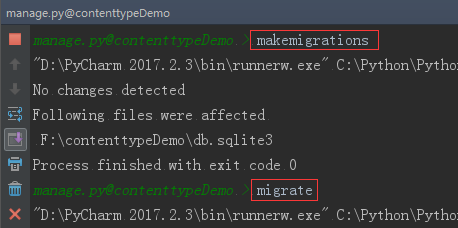
3.存著所有app的名字、表名字。

每當我們建立了新的model並執行資料庫遷移後,ContentType表中就會自動新增一條記錄。比如我在應用app01的models.py中建立表class Electrics(models.Model): pass。從資料庫檢視ContentType表,顯示如下:
| id | app_label | model |
|---|---|---|
| … | admin, auth等內建應用… | … |
| 5 | contenttypes | contenttype |
| 6 | app01 | electrics |
那麼這個表有什麼作用呢?這裡提供一個場景,網上商城購物時,會有各種各樣的優惠券,比如通用優惠券,滿減券,或者是僅限特定品類的優惠券。在資料庫中,可以通過外來鍵將優惠券和不同品類的商品表關聯起來:
from django.db import models class Electrics(models.Model): """ id name 1 日立冰箱 2 三星電視 3 小天鵝洗衣機 """ name = models.CharField(max_length=32) class Foods(models.Model):""" id name 1 麵包 2 烤鴨 """ name = models.CharField(max_length=32) class Clothes(models.Model): name = models.CharField(max_length=32) class Coupon(models.Model): # 特殊關係表
"""
id name electric_id food_id cloth_id more... # 每增加一張表,關係表的結構就要多加一個欄位。
1 通用優惠券 null null null
2 冰箱滿減券 2 null null
3 麵包狂歡節 null 1 null
"""
name = models.CharField(max_length=32)
electric = models.ForeignKey(to='Electrics', null=True)
food = models.ForeignKey(to='Foods', null=True)
cloth = models.ForeignKey(to='Clothes', null=True)
如果是通用優惠券,那麼所有的ForeignKey為null,如果僅限某些商品,那麼對應商品ForeignKey記錄該商品的id,不相關的記錄為null。但是這樣做是有問題的:實際中商品品類繁多,而且很可能還會持續增加,那麼優惠券表中的外來鍵將越來越多,但是每條記錄僅使用其中的一個或某幾個外來鍵欄位。
contenttypes 應用
通過使用contenttypes 應用中提供的特殊欄位GenericForeignKey,我們可以很好的解決這個問題。只需要以下三步:
- 在model中定義ForeignKey欄位,並關聯到ContentType表。通常這個欄位命名為“content_type”
- 在model中定義PositiveIntegerField欄位,用來儲存關聯表中的主鍵。通常這個欄位命名為“object_id”
- 在model中定義GenericForeignKey欄位,傳入上述兩個欄位的名字。
為了更方便查詢商品的優惠券,我們還可以在商品類中通過GenericRelation欄位定義反向關係。
示例程式碼:
from django.db import models from django.contrib.contenttypes.models import ContentType from django.contrib.contenttypes.fields import GenericForeignKey,GenericRelation class Electrics(models.Model): name = models.CharField(max_length=32) price = models.IntegerField(default=100) coupons = GenericRelation(to='Coupon') def __str__(self): return self.name class Foods(models.Model): name = models.CharField(max_length=32) price=models.IntegerField(default=100) coupons = GenericRelation(to='Coupon') def __str__(self): return self.name class Clothes(models.Model): name = models.CharField(max_length=32) price = models.IntegerField(default=100) coupons = GenericRelation(to='Coupon') def __str__(self): return self.name class bed(models.Model): name = models.CharField(max_length=32) price = models.IntegerField(default=100) coupons = GenericRelation(to='Coupon') class Coupon(models.Model): """ Coupon id name content_type_id object_id_id 1 美的滿減優惠券 9(電器表electrics) 3 2 豬蹄買一送一優惠券 10 2 3 南極被子買200減50優惠券 11 1 """ name = models.CharField(max_length=32) content_type = models.ForeignKey(to=ContentType) # step 1 object_id = models.PositiveIntegerField() # step 2 content_object = GenericForeignKey('content_type', 'object_id') # step 3 def __str__(self): return self.name
注意:ContentType只運用於1對多的關係!!!並且多的那張表中有多個ForeignKey欄位。
4.資料化遷移,再給每張表新增資料。
4.1.衣服表。
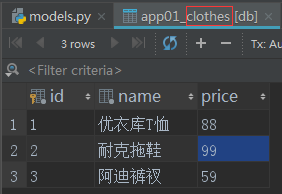
4.2.電器表。

4.3.食物表。
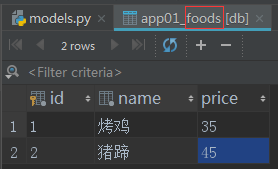
4.4.django_content_type表。

5.再加一張表(床上用品表),資料遷移後,新增幾條資料。
class bed(models.Model): name = models.CharField(max_length=32) coupons = GenericRelation(to='Coupon')
5.1床上用品表
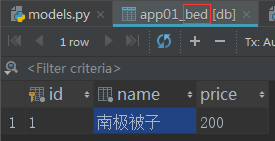
建立記錄和查詢
from django.shortcuts import render, HttpResponse from app01 import models from django.contrib.contenttypes.models import ContentType def test(request): if request.method == 'GET': # ContentType表物件有model_class() 方法,取到對應model content = ContentType.objects.filter(app_label='app01', model='electrics').first() # 表名小寫 cloth_class = content.model_class() # cloth_class 就相當於models.Electrics res = cloth_class.objects.all() print(res) # 為三星電視(id=2)建立一條優惠記錄 s_tv = models.Electrics.objects.filter(id=2).first() models.Coupon.objects.create(name='電視優惠券', content_object=s_tv) # 查詢優惠券(id=1)綁定了哪個商品 coupon_obj = models.Coupon.objects.filter(id=1).first() prod = coupon_obj.content_object print(prod) # 查詢三星電視(id=2)的所有優惠券 res = s_tv.coupons.all() print(res) # 查詢obj的所有優惠券:如果沒有定義反向查詢欄位,通過如下方式: content = ContentType.objects.filter(app_label='app01', model='model_name').first() res = models.OftenAskedQuestion.objects.filter(content_type=content, object_id=obj.pk).all() return HttpResponse('....')
總結:
當一張表和多個表FK關聯,並且多個FK中只能選擇其中一個或其中n個時,可以利用contenttypes app,只需定義三個欄位就搞定!
建立記錄
關係表的結構

注意:直接用表加,object_id寫不了。

6.用語法給關係表加記錄。
6.1新增方式1:
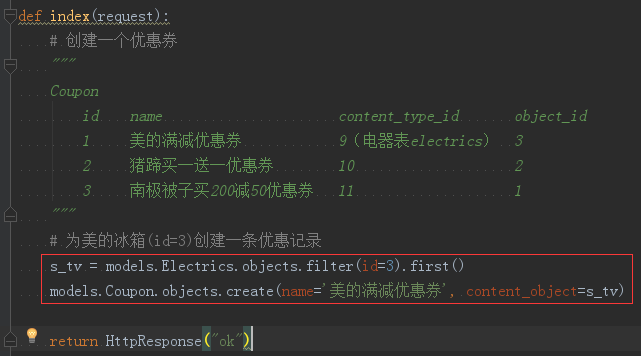

檢視關係表記錄

6.2新增方式2:
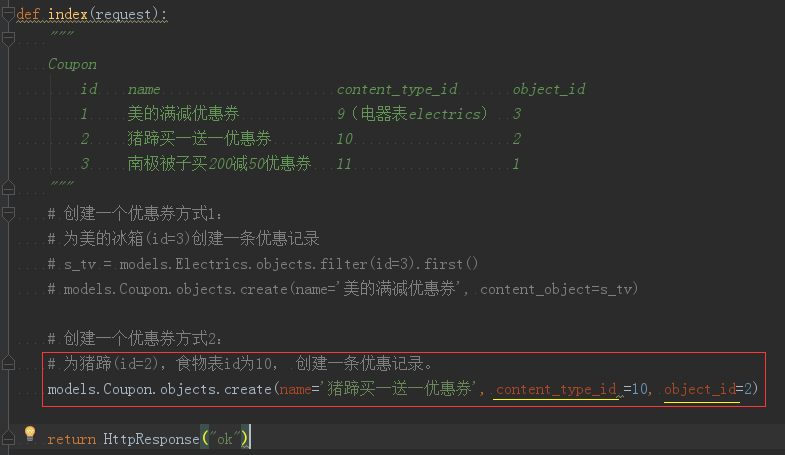
檢視關係表記錄

程式碼:
from django.shortcuts import render,HttpResponse # Create your views here. from app01 import models def index(request): """ Coupon id name content_type_id object_id 1 美的滿減優惠券 9(電器表electrics) 3 2 豬蹄買一送一優惠券 10 2 3 南極被子買200減50優惠券 11 1 """ # 建立一個優惠券方式1: # 為美的冰箱(id=3)建立一條優惠記錄 # s_tv = models.Electrics.objects.filter(id=3).first() # models.Coupon.objects.create(name='美的滿減優惠券', content_object=s_tv) # 建立一個優惠券方式2: # 為豬蹄(id=2),食物表id為10, 建立一條優惠記錄。 models.Coupon.objects.create(name='豬蹄買一送一優惠券', content_type_id =10, object_id=2) return HttpResponse("ok")
查詢記錄
7.查詢‘豬蹄買一送一優惠券’對應商品的價格。
from app01 import models coupon = models.Coupon.objects.filter(name="豬蹄買一送一優惠券").first() coupon <Coupon: 豬蹄買一送一優惠券> coupon.content_type <ContentType: foods> coupon.content_type.model 'foods' coupon.object_id 2 coupon.content_type.model_class() <class 'app01.models.Foods'> coupon.content_type.model_class().objects.filter(pk=coupon.object_id) <QuerySet [<Foods: 豬蹄>]> coupon.content_type.model_class().objects.filter(pk=coupon.object_id).first().price coupon.content_object <Foods: 豬蹄> coupon.content_object.price
45




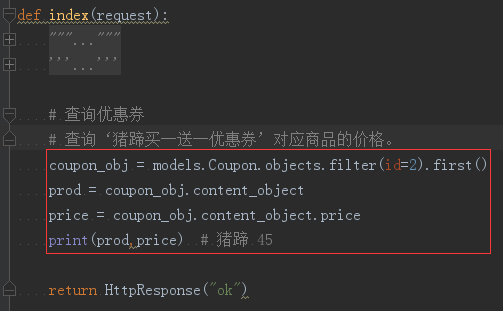

from django.shortcuts import render,HttpResponse # Create your views here. from app01 import models def index(request): """ Coupon id name content_type_id object_id 1 美的滿減優惠券 9(電器表electrics) 3 2 豬蹄買一送一優惠券 10 2 3 南極被子買200減50優惠券 11 1 """ ''' #新增優惠券 # 建立一個優惠券方式1: # 為美的冰箱(id=3)建立一條優惠記錄 # s_tv = models.Electrics.objects.filter(id=3).first() # models.Coupon.objects.create(name='美的滿減優惠券', content_object=s_tv) # 建立一個優惠券方式2: # 為豬蹄(id=2),食物表id為10, 建立一條優惠記錄。 models.Coupon.objects.create(name='豬蹄買一送一優惠券', content_type_id =10, object_id=2) ''' # 查詢優惠券 ''' # 查詢‘豬蹄買一送一優惠券’對應商品的價格。 coupon_obj = models.Coupon.objects.filter(id=2).first() prod = coupon_obj.content_object price = coupon_obj.content_object.price print(prod,price) # 豬蹄 45 ''' # 美的冰箱所有的優惠券 return HttpResponse("ok")View Code
8.美的冰箱所有的優惠券

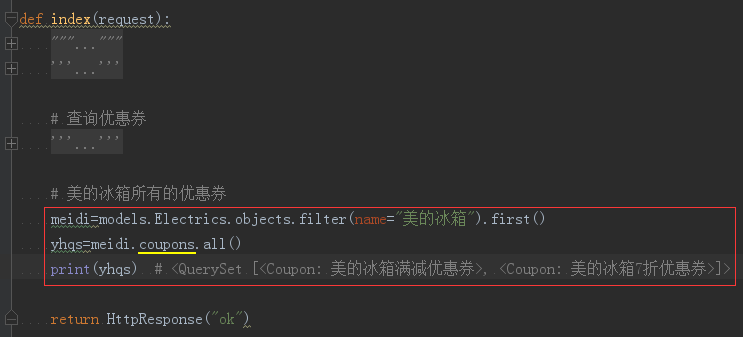

from django.shortcuts import render,HttpResponse # Create your views here. from app01 import models def index(request): """ Coupon id name content_type_id object_id 1 美的滿減優惠券 9(電器表electrics) 3 2 豬蹄買一送一優惠券 10 2 3 南極被子買200減50優惠券 11 1 """ ''' #新增優惠券 # 建立一個優惠券方式1: # 為美的冰箱(id=3)建立一條優惠記錄 # s_tv = models.Electrics.objects.filter(id=3).first() # models.Coupon.objects.create(name='美的滿減優惠券', content_object=s_tv) # 建立一個優惠券方式2: # 為豬蹄(id=2),食物表id為10, 建立一條優惠記錄。 models.Coupon.objects.create(name='豬蹄買一送一優惠券', content_type_id =10, object_id=2) ''' # 查詢優惠券 ''' # 查詢‘豬蹄買一送一優惠券’對應商品的價格。 coupon_obj = models.Coupon.objects.filter(id=2).first() prod = coupon_obj.content_object price = coupon_obj.content_object.price print(prod,price) # 豬蹄 45 ''' # 美的冰箱所有的優惠券 meidi=models.Electrics.objects.filter(name="美的冰箱").first() yhqs=meidi.coupons.all() print(yhqs) # <QuerySet [<Coupon: 美的冰箱滿減優惠券>, <Coupon: 美的冰箱7折優惠券>]> return HttpResponse("ok")View Code
路飛學城類似的表關係

course(專題課程) id name id name 1 flasky原始碼 degree(學位課程) id name id name 1 python全棧開發 Price strategy(價格策略) id price period course_id degree_id id price period course_id degree_id 1 100 1周 1 2 200 4周 1 3 600 9周 1 OftenQuestion # 問題表 id title course_id degree_id id title course_id degree_id 1 flask怎麼下載 1 2 flask文件如何去讀 1View Code
1.建立一個專案

2.資料庫遷移,生成預設表。


3.存著所有app的名字、表名字。

每當我們建立了新的model並執行資料庫遷移後,ContentType表中就會自動新增一條記錄。比如我在應用app01的models.py中建立表class Electrics(models.Model): pass。從資料庫檢視ContentType表,顯示如下:
| id | app_label | model |
|---|---|---|
| … | admin, auth等內建應用… | … |
| 5 | contenttypes | contenttype |
| 6 | app01 | electrics |
那麼這個表有什麼作用呢?這裡提供一個場景,網上商城購物時,會有各種各樣的優惠券,比如通用優惠券,滿減券,或者是僅限特定品類的優惠券。在資料庫中,可以通過外來鍵將優惠券和不同品類的商品表關聯起來:
from django.db import models class Electrics(models.Model): """ id name 1 日立冰箱 2 三星電視 3 小天鵝洗衣機 """ name = models.CharField(max_length=32) class Foods(models.Model): """ id name 1 麵包 2 烤鴨 """ name = models.CharField(max_length=32) class Clothes(models.Model): name = models.CharField(max_length=32) class Coupon(models.Model): # 特殊關係表
"""
id name electric_id food_id cloth_id more... # 每增加一張表,關係表的結構就要多加一個欄位。
1 通用優惠券 null null null
2 冰箱滿減券 2 null null
3 麵包狂歡節 null 1 null
"""
name = models.CharField(max_length=32)
electric = models.ForeignKey(to='Electrics', null=True)
food = models.ForeignKey(to='Foods', null=True)
cloth = models.ForeignKey(to='Clothes', null=True)
如果是通用優惠券,那麼所有的ForeignKey為null,如果僅限某些商品,那麼對應商品ForeignKey記錄該商品的id,不相關的記錄為null。但是這樣做是有問題的:實際中商品品類繁多,而且很可能還會持續增加,那麼優惠券表中的外來鍵將越來越多,但是每條記錄僅使用其中的一個或某幾個外來鍵欄位。
contenttypes 應用
通過使用contenttypes 應用中提供的特殊欄位GenericForeignKey,我們可以很好的解決這個問題。只需要以下三步:
- 在model中定義ForeignKey欄位,並關聯到ContentType表。通常這個欄位命名為“content_type”
- 在model中定義PositiveIntegerField欄位,用來儲存關聯表中的主鍵。通常這個欄位命名為“object_id”
- 在model中定義GenericForeignKey欄位,傳入上述兩個欄位的名字。
為了更方便查詢商品的優惠券,我們還可以在商品類中通過GenericRelation欄位定義反向關係。
示例程式碼:
from django.db import models from django.contrib.contenttypes.models import ContentType from django.contrib.contenttypes.fields import GenericForeignKey,GenericRelation class Electrics(models.Model): name = models.CharField(max_length=32) price = models.IntegerField(default=100) coupons = GenericRelation(to='Coupon') def __str__(self): return self.name class Foods(models.Model): name = models.CharField(max_length=32) price=models.IntegerField(default=100) coupons = GenericRelation(to='Coupon') def __str__(self): return self.name class Clothes(models.Model): name = models.CharField(max_length=32) price = models.IntegerField(default=100) coupons = GenericRelation(to='Coupon') def __str__(self): return self.name class bed(models.Model): name = models.CharField(max_length=32) price = models.IntegerField(default=100) coupons = GenericRelation(to='Coupon') class Coupon(models.Model): """ Coupon id name content_type_id object_id_id 1 美的滿減優惠券 9(電器表electrics) 3 2 豬蹄買一送一優惠券 10 2 3 南極被子買200減50優惠券 11 1 """ name = models.CharField(max_length=32) content_type = models.ForeignKey(to=ContentType) # step 1 object_id = models.PositiveIntegerField() # step 2 content_object = GenericForeignKey('content_type', 'object_id') # step 3 def __str__(self): return self.name
注意:ContentType只運用於1對多的關係!!!並且多的那張表中有多個ForeignKey欄位。
4.資料化遷移,再給每張表新增資料。
4.1.衣服表。

4.2.電器表。

4.3.食物表。

4.4.django_content_type表。

5.再加一張表(床上用品表),資料遷移後,新增幾條資料。
class bed(models.Model): name = models.CharField(max_length=32) coupons = GenericRelation(to='Coupon')
5.1床上用品表

建立記錄和查詢
from django.shortcuts import render, HttpResponse from app01 import models from django.contrib.contenttypes.models import ContentType def test(request): if request.method == 'GET': # ContentType表物件有model_class() 方法,取到對應model content = ContentType.objects.filter(app_label='app01', model='electrics').first() # 表名小寫 cloth_class = content.model_class() # cloth_class 就相當於models.Electrics res = cloth_class.objects.all() print(res) # 為三星電視(id=2)建立一條優惠記錄 s_tv = models.Electrics.objects.filter(id=2).first() models.Coupon.objects.create(name='電視優惠券', content_object=s_tv) # 查詢優惠券(id=1)綁定了哪個商品 coupon_obj = models.Coupon.objects.filter(id=1).first() prod = coupon_obj.content_object print(prod) # 查詢三星電視(id=2)的所有優惠券 res = s_tv.coupons.all() print(res) # 查詢obj的所有優惠券:如果沒有定義反向查詢欄位,通過如下方式: content = ContentType.objects.filter(app_label='app01', model='model_name').first() res = models.OftenAskedQuestion.objects.filter(content_type=content, object_id=obj.pk).all() return HttpResponse('....')
總結:
當一張表和多個表FK關聯,並且多個FK中只能選擇其中一個或其中n個時,可以利用contenttypes app,只需定義三個欄位就搞定!
建立記錄
關係表的結構

注意:直接用表加,object_id寫不了。

6.用語法給關係表加記錄。
6.1新增方式1:


檢視關係表記錄

6.2新增方式2:

檢視關係表記錄

程式碼:
from django.shortcuts import render,HttpResponse # Create your views here. from app01 import models def index(request): """ Coupon id name content_type_id object_id 1 美的滿減優惠券 9(電器表electrics) 3 2 豬蹄買一送一優惠券 10 2 3 南極被子買200減50優惠券 11 1 """ # 建立一個優惠券方式1: # 為美的冰箱(id=3)建立一條優惠記錄 # s_tv = models.Electrics.objects.filter(id=3).first() # models.Coupon.objects.create(name='美的滿減優惠券', content_object=s_tv) # 建立一個優惠券方式2: # 為豬蹄(id=2),食物表id為10, 建立一條優惠記錄。 models.Coupon.objects.create(name='豬蹄買一送一優惠券', content_type_id =10, object_id=2) return HttpResponse("ok")
查詢記錄
7.查詢‘豬蹄買一送一優惠券’對應商品的價格。
from app01 import models coupon = models.Coupon.objects.filter(name="豬蹄買一送一優惠券").first() coupon <Coupon: 豬蹄買一送一優惠券> coupon.content_type <ContentType: foods> coupon.content_type.model 'foods' coupon.object_id 2 coupon.content_type.model_class() <class 'app01.models.Foods'> coupon.content_type.model_class().objects.filter(pk=coupon.object_id) <QuerySet [<Foods: 豬蹄>]> coupon.content_type.model_class().objects.filter(pk=coupon.object_id).first().price coupon.content_object <Foods: 豬蹄> coupon.content_object.price
45






from django.shortcuts import render,HttpResponse # Create your views here. from app01 import models def index(request): """ Coupon id name content_type_id object_id 1 美的滿減優惠券 9(電器表electrics) 3 2 豬蹄買一送一優惠券 10 2 3 南極被子買200減50優惠券 11 1 """ ''' #新增優惠券 # 建立一個優惠券方式1: # 為美的冰箱(id=3)建立一條優惠記錄 # s_tv = models.Electrics.objects.filter(id=3).first() # models.Coupon.objects.create(name='美的滿減優惠券', content_object=s_tv) # 建立一個優惠券方式2: # 為豬蹄(id=2),食物表id為10, 建立一條優惠記錄。 models.Coupon.objects.create(name='豬蹄買一送一優惠券', content_type_id =10, object_id=2) ''' # 查詢優惠券 ''' # 查詢‘豬蹄買一送一優惠券’對應商品的價格。 coupon_obj = models.Coupon.objects.filter(id=2).first() prod = coupon_obj.content_object price = coupon_obj.content_object.price print(prod,price) # 豬蹄 45 ''' # 美的冰箱所有的優惠券 return HttpResponse("ok")View Code
8.美的冰箱所有的優惠券



from django.shortcuts import render,HttpResponse # Create your views here. from app01 import models def index(request): """ Coupon id name content_type_id object_id 1 美的滿減優惠券 9(電器表electrics) 3 2 豬蹄買一送一優惠券 10 2 3 南極被子買200減50優惠券 11 1 """ ''' #新增優惠券 # 建立一個優惠券方式1: # 為美的冰箱(id=3)建立一條優惠記錄 # s_tv = models.Electrics.objects.filter(id=3).first() # models.Coupon.objects.create(name='美的滿減優惠券', content_object=s_tv) # 建立一個優惠券方式2: # 為豬蹄(id=2),食物表id為10, 建立一條優惠記錄。 models.Coupon.objects.create(name='豬蹄買一送一優惠券', content_type_id =10, object_id=2) ''' # 查詢優惠券 ''' # 查詢‘豬蹄買一送一優惠券’對應商品的價格。 coupon_obj = models.Coupon.objects.filter(id=2).first() prod = coupon_obj.content_object price = coupon_obj.content_object.price print(prod,price) # 豬蹄 45 ''' # 美的冰箱所有的優惠券 meidi=models.Electrics.objects.filter(name="美的冰箱").first() yhqs=meidi.coupons.all() print(yhqs) # <QuerySet [<Coupon: 美的冰箱滿減優惠券>, <Coupon: 美的冰箱7折優惠券>]> return HttpResponse("ok")View Code
路飛學城類似的表關係

course(專題課程) id name id name 1 flasky原始碼 degree(學位課程) id name id name 1 python全棧開發 Price strategy(價格策略) id price period course_id degree_id id price period course_id degree_id 1 100 1周 1 2 200 4周 1 3 600 9周 1 OftenQuestion # 問題表 id title course_id degree_id id title course_id degree_id 1 flask怎麼下載 1 2 flask文件如何去讀 1View Code

